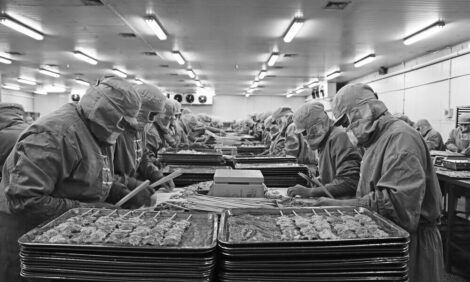



Feed Prices Forecast to Stay Low
ANALYSIS - There are no signs of a rise in feed prices on the horizon – at least, not yet - according to the latest forecast presented at the AHDB Outlook Conference in London earlier this week, reports Jackie Linden.Following three years of good harvests, global stocks of key feed ingredients, wheat, maize (corn) and soybeans have risen, reported Brenda Mullan, Acting Senior Analyst with the Agricultural and Horticultural Development Board (AHDB). She was speaking at the AHDB Outlook 2016 conference in London on 9 February.

Currency fluctuations and low crude oil prices are impacting export competitiveness and demand potential.
Driving animal feed demand in the UK are the pig and poultry sectors. While poultry production is expected to continue its upward trajectory, Ms Mullan said that the current low pig prices could jeopardise growth in that sector later this year.
Overall, she said, there are no reasons to indicate an imminent increase in feed prices.
Overview of the Global Market: a 4th Year if Grain Surplus?
Globally, there have been three successive years of global grain surplus, according to Ms Mullan. This applies to wheat and coarse grains (maize, barley and sorghum), and explains why grain prices have maintained a downward trend.
If a fourth year of surplus were to be achieved, it would be for the first time in almost 40 years.
“However, we’re just one weather or other event away from the next change in direction,” she warned, “and we’re still six months away from next season’s harvest in the Northern Hemisphere.”
The global oilseed market is driven by soybeans, which are also in surplus this year. However, production is at a crucial stage in the key production area, South America so it is too soon to predict this year’s output. The situation is also impacted by the recent change of government in Argentina. In Brazil, soybean harvesting is now underway.
Rapeseed is the main oilseed crop grown in the UK, and supplies have been tighter than soybeans this year, and the same is expected for the coming crop season.
Ms Mullan said that crude oil has a considerable effect on grain and oilseed prices. Crude oil prices closely match exchange rate changes in terms of the value of the Russian ruble against the US dollar, reflecting the importance of Russia in exporting grains as Moscow’s export policies are linked to the exchange rate. Any change in policy has the potential to have a massive impact on global grain prices, she said.
On the demand side, the changing state of the Chinese economy can have a significant impact on the global markets.
Currencies can change export competitiveness. The weakening of the UK pound against the US dollar and the Euro over the second half of 2015 should have made UK exports more competitive but market fundamentals have prevented the full exploitation of that situation.
UK Market Overview
Turning attention to the markets in the UK, Ms Mullan said that stocks of wheat are building following a huge harvest of more than 16 million tonnes last year. The forecast this year is marginally lower, as is demand so there are likely to be opportunities to build stock and/or increase exports this year.
Number 2 feed ingredient in the UK is barley, which also turned in a huge harvest in 2014/15. The forecast is also slightly lower for this year. The export situation for barley is better than for wheat, according to Ms Mullan, if it can feed into the niche demand from non-EU markets, where barely harvests have been in long-term decline.
The price differential between wheat and barley is a key measure for feed companies in their decisions regarding ration formulations. This difference has declined substantially since mid-2015, resulting in a forecast barley surplus of 2.7 million tonnes this year and increasing the drive for more exports.
Imported maize is not an economical choice for inclusion in UK feeds, based on its price relative to home-grown wheat as a feed ingredient. Ms Mullan noted, however, that large volumes of maize are coming into the country, competing with domestic wheat. With the latest government figures showing no increase in the use of maize in feed, the purpose to the additional maize is uncertain.
Wheat exports have only just started, six months into the marketing year. Spot prices are well below forward futures prices, encouraging wheat producers to hold back as much as possible in store.
Overall, animal feed production for the second half of 2015 was up 2 per cent in the UK, driven especially by the poultry sector and, to a lesser extent, by pigs. The volumes of both cattle and sheep feeds were lower over that period than in the year before, affected by falling animal numbers and more favourable conditions for grazing and forage feeding. Future pig feed production may be impacted by the current low pig prices.
Ms Mullan highlighted the increase in pulses (peas and beans) used in animal feeds in the UK, with the quantity up by more than 150 per cent between 2014/15 and 2015/16. Not only have inclusion rates in feed increased, so too has the area planted to these crops. They represent a useful break crop from cereals – offering soil-improving benefits – and they have become more profitable for arable farmers to grow than rapeseed. It is unclear whether these rises in the cultivation and use of pulses in feeds are the start of a long-term trend.
Prospects for 2016
Looking into her crystal ball for indications of UK feed crop prospects for this year, Ms Mullan highlighted farmers’ intentions to grow more oats and pulses, and less rapeseed than last season. Acreage of the country’s top cereal crop, wheat, is expected to be about the same as last year.
For barley, an increase in acreage of spring barley will more than compensate for a smaller area of the winter crop.
Looking further afield, early indications are that EU-28 has had a good start to the growing season, with no significant changes in the areas planted to wheat or rapeseed. Canada’s wheat area is also forecast to be stable. Drought conditions in key states in the US have now eased, and now the spring crop could be crucial as winter crop sowings were cut back.
In Russia and Ukraine, dry conditions delayed planting, which increases the risks of damage caused by cold weather and may lead to increased areas sown with spring crops. Rainfall is needed for crops in India and North Africa to establish.








